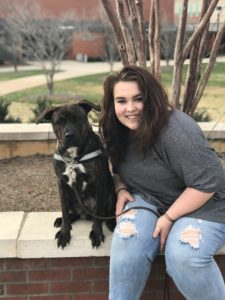WCU students were in for a ruff day after finding out the puppies that they were training didn’t qualify as service dogs in training and had to be sent away.
Last year, Service Dogs Warren Retrievers, an organization that trains service dogs, gave students fluffy golden retriever puppies wearing “service dog in training” vests. The students were expected to give the puppies basic obedience training and socialization.
However, since the puppies weren’t being trained to perform a specific task, they didn’t qualify as service dogs in training and were removed from campus.
Wesley Satterwhite, the director of the Office of Accessibility Resources (OAR), claims that the organization is unethical.
“I did some research on that organization and it’s not actually a good business practices organization,” said Satterwhite. “They have a lot of unethical business practices.”

Sophomore Tyler Spurling with his emotional support animal, Belle. Photo by Keegan Wiggins
In addition to this incident, WCU has seen an increase in emotional support animals.
According to Satterwhite, in recent years, there has been an influx of emotional support animals in residence halls. In 2014, WCU housed roughly 15 ESAs and now, WCU houses about 50.
Wesley Satterwhite, the director of the Office of Accessibility Resources (OAR), thinks this increase in ESAs is the cause of confusion surrounding the differences between SAs, ESAs and service dogs in training.
Service animals (SAs) and emotional support animals (ESAs) alike change the lives of the people they support.
For SAs, it can be for guiding a person that is blind, calming a person with Post Traumatic Stress Disorder (PTSD) during a panic attack, protecting a person that is having a seizure, or reminding a person with a mental disability to take their prescriptions.
For ESAs, it can be for relieving loneliness, providing companionship or helping someone with depression, anxiety or even specific phobias.
While they both assist people, there is a major difference between the two.
According to the American with Disabilities Act (ADA), a service animal is:
“any dog that is individually trained to do work or perform tasks for the benefit of an individual with a disability, including a physical, sensory, psychiatric, intellectual, or other mental disability.”
A service animal can also be a miniature horse. However, there a physical limitations with miniature horses because sometimes they are too big and cannot fit in areas where a service dog can.
An ESA can be any animal. However, at WCU, Residential Living won’t allow animals that are prone harming students or causing a lot of damage.
Bryant Barnett, the Executive Director of Residential Living, says they look at multiple factors when approving what type of animal is allowed in the residence halls.
“Is it an animal that can be trained, so an animal that can be potty trained,” said Barnett. “Theoretically, it can be anything, but in a residence hall, is it known to be an animal to make a lot of damage?”
In an attempt to clear the confusion, Satterwhite and the OAR have created a Fast Facts about Animals on Campus document and an ESA checklist.
The ESA checklist can be picked up from Lisa Surber, the Room Assignments Coordinator, at Residential Living.
The list includes information such as has the student submitted their accommodation form, current veterinary records and paid their housing deposit.
“I think we are working towards being clearer, but because of such a short period of time and such an explosion it’s really hard to communicate that clearly,” said Satterwhite.

Haleigh Harrison with her service dog in training, O.S. Berkley. Photo by Jake Viers
When it comes to having the animal approved on campus, SAs, ESAs and service dogs in training are required to go through residential living. This is to make sure that the animal is up to date with its rabies shots.
Students need to fill out an accommodation form through residential living and provide documentation that shows the animal is up to date with its shots.
However, SAs aren’t required to share documentation or fill out a request form with OAR, but Satterwhite recommends students still do it anyway.
According to Satterwhite, it would help cut down confusion and problems that students have had in the past on campus.
“I think if the student were to, or the individual even if they are member of the public, if they were to let us know, that would help us to educate others,” said Satterwhite.
In total, the process could last anywhere from one day to two weeks. It depends on whether or not Satterwhite and Surber are in the office, how many requests they have and if the documentation was filled out properly.
Barnett recommends that students should learn about the process of bringing either an ESA or SA on campus prior to bring the animal. He says it’s a lot better to ask questions beforehand than to get in trouble for not following the process correctly.
“I think in the end you’re not only helping yourself in the process in speeding it along, but your helping others that are in your same boat that have to deal with being asked questions that they shouldn’t have to be,” said Barnett. “It would make things much easier for everybody if it’s done appropriately in the steps that is should take in order to get it done.”
If you have any questions or are in the process of bringing an ESA or SA, you can contact Wesley Satterwhite at 828-227-3886 or email her at wsatterwhite@wcu.edu.


